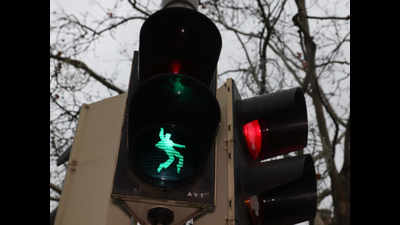- News
- City News
- delhi News
- Delhi: Jaywalking takes joy out, but road designs to blame too
Trending
This story is from December 14, 2018
Delhi: Jaywalking takes joy out, but road designs to blame too

Image used for representational purpose only
NEW DELHI: With road policies hardly centred on pedestrian movement, walkers bear the brunt of traffic incidents. The records show that 22% of all victims killed in city accidents are those attempting to cross the road. Trying to get to the other side of the road in this manner could qualify as jaywalking, and though the Motor Vehicles Act provides for a fine of Rs 50 for such acts, police say that violators are seldom booked.
According to a traffic police study, the most dangerous road stretches are T-junctions and two-lane roads where vehicles try to overtake each other. Normally, cars attempting to overtake from the left side knock down the victims. Last year, private car drivers were the biggest killers, while speeding beyond the permitted limit was the reason for a fifth of the accidents.
The cops say that figures show areas around Badarpur, Tughlaqabad and Sarita Vihar as least prone to pedestrian deaths due to the high density of cars on the roads. Ring Road is the deadliest, with 123 fatal accidents logged on it last year. The police study revealed that 45% of the accidents could be attributed to driver’s fault, while the rest were the combined faults of cars and pedestrians.
Improper road designs and crossing points are a big factor in road accidents. Narrow roads were behind 44% of the accidents, while the lack of a central verge to ease the passage of pedestrians was the cause of 41% of the deaths. Poor road illumination accounted for 22% of the accidents.
The figures show that around 46% of the total accidents were caused by speeding and reckless driving. Observing how fatal speeding can be, the police study inferred that pedestrians had a 90% chance of survival if hit by a car travelling 30 kmph or slower.
Police have proposed the lanes being segregated into four zones for slow movers, public transport, vehicles moving at 20-40 kmph and those at higher speeds, with two wheelers restricted to the third zone to avoid conflict with four wheelers.
According to a traffic police study, the most dangerous road stretches are T-junctions and two-lane roads where vehicles try to overtake each other. Normally, cars attempting to overtake from the left side knock down the victims. Last year, private car drivers were the biggest killers, while speeding beyond the permitted limit was the reason for a fifth of the accidents.
The cops say that figures show areas around Badarpur, Tughlaqabad and Sarita Vihar as least prone to pedestrian deaths due to the high density of cars on the roads. Ring Road is the deadliest, with 123 fatal accidents logged on it last year. The police study revealed that 45% of the accidents could be attributed to driver’s fault, while the rest were the combined faults of cars and pedestrians.
Improper road designs and crossing points are a big factor in road accidents. Narrow roads were behind 44% of the accidents, while the lack of a central verge to ease the passage of pedestrians was the cause of 41% of the deaths. Poor road illumination accounted for 22% of the accidents.
A ministry of road transport report said that last year, 583 pedestrians involved in accidents suffered grievous injuries, 5,088 had minor injuries, and 156 escaped unhurt. The number killed at unmanned crossings was 264, while 163 died due to drivers jumping a traffic signal.
The figures show that around 46% of the total accidents were caused by speeding and reckless driving. Observing how fatal speeding can be, the police study inferred that pedestrians had a 90% chance of survival if hit by a car travelling 30 kmph or slower.
Police have proposed the lanes being segregated into four zones for slow movers, public transport, vehicles moving at 20-40 kmph and those at higher speeds, with two wheelers restricted to the third zone to avoid conflict with four wheelers.
End of Article
FOLLOW US ON SOCIAL MEDIA










